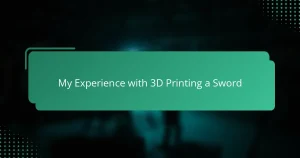Key takeaways
- Science fiction props serve as creative tools that evoke emotion and spark curiosity, bridging imagination and reality.
- Essential tools such as precision screwdrivers, 3D modeling software, and basic crafting supplies are crucial for successful prop design.
- Choosing the right materials enhances the realism and storytelling potential of props, balancing futuristic aesthetics with practicality.
- Patience and flexibility are vital in prop creation, allowing for improvements and creative solutions throughout the design process.

Understanding Science Fiction Props
Science fiction props aren’t just objects; they’re gateways into other worlds. When I first handled a prop blaster, I felt the thrill of holding a piece of imagination made real. Have you ever wondered how a simple-looking gadget can tell a story all by itself?
In my experience, understanding these props means appreciating their design as much as their function. They blend creativity and technology, often pushing the boundaries of what we consider possible. It’s fascinating how a prop’s look can spark ideas about the universe it belongs to.
What makes sci-fi props truly special is their power to evoke emotion and curiosity. When I design, I think about how each detail might inspire someone else to dream bigger. Don’t you find that these props invite you to explore not just the story but the mind behind it?

Essential Tools for Prop Design
When I first started designing my sci-fi gun, I quickly realized that having the right tools made all the difference. A good set of precision screwdrivers and a reliable cutting knife became my closest companions—they allowed me to shape and adjust parts with confidence. Have you ever struggled to get a clean edge or a perfect fit? These tools save you from frustration and keep the creative flow alive.
I also found that digital tools like 3D modeling software were game changers in how I visualized my design before even touching physical materials. Sketching ideas on paper is great, but being able to rotate and tweak a virtual model added a whole new dimension to the process. It felt like bringing my imagination into a tangible space where every curve and detail could be perfected.
Of course, no prop design can do without some basic crafting supplies—glue, paintbrushes, and sandpaper are essentials that I never overlook. They help add that layer of realism and wear that transforms a simple object into something that looks like it’s been through epic space battles. Have you noticed how subtle textures and finishes can really sell the story behind a prop? That’s the magic these humble tools bring.

Choosing Materials for Sci-Fi Guns
Choosing the right materials for my sci-fi gun was where imagination met reality. I remember holding a chunk of lightweight plastic and thinking, “Could this convey alien technology without feeling flimsy?” It taught me that materials must look futuristic but still feel sturdy in the hand.
Metal components bring a sense of weight and authenticity, but they can be heavy and tricky to work with. I often mixed metal with acrylic parts to strike a balance—giving the gun that solid, industrial vibe while keeping it wearable. Have you ever noticed how a cold metallic surface can instantly raise the stakes of a prop’s story?
Then there’s the finish—paints and coatings can transform simple plastics into glowing energy conduits or battle-worn relics. I found layering translucent paints gave my gun a depth that plain colors never could. It’s amazing how a careful choice of materials and textures can make your creation feel like it belongs in another universe.

Designing the Sci-Fi Gun Concept
Designing the concept for my sci-fi gun started with imagining its story and purpose. I asked myself, what kind of world does this weapon belong to? The answers shaped everything—from its silhouette to the smallest details on its surface.
I like to think of the concept phase as sketching thoughts in the air before they ever hit paper. Sometimes, ideas come from unexpected places—a shape seen in architecture or a pattern found in nature. Have you ever caught yourself inspired by something totally unrelated? That’s where the fun begins.
Balancing creativity with practicality was another challenge. I wanted the gun to look futuristic but also feel like it could function within its universe. It’s like building a believable myth; if even one detail feels off, the whole illusion can break. How do you blend imagination with believability? For me, it’s about respecting both story and design equally.

Building the Sci-Fi Gun Model
Building the sci-fi gun model was like bringing a dream into my workshop. I started by assembling basic shapes with foam and plastic, carefully layering and carving until the form began to feel alive. Have you ever noticed how turning flat pieces into three-dimensional shapes suddenly adds a new sense of possibility?
As the parts took shape, I experienced moments of both excitement and frustration—gluing tiny components in tricky spots tested my patience more than once. But each challenge reminded me that attention to detail is what breathes life into a prop. Isn’t it amazing how a few well-placed screws or grooves can transform an object from simple to spectacular?
Finishing touches were where the model truly found its voice. I painted and weathered the surfaces to suggest years of use and hidden technology, sometimes stepping back just to absorb how those subtle effects told a story all on their own. Do you find that the tiniest scratches and highlights can reveal as much character as the overall design? To me, that’s the heart of building a sci-fi gun model.

Adding Details and Finishing Touches
Adding details is where my sci-fi gun really started to come alive. I’d spend hours tweaking tiny panels, etching circuit-like patterns, and attaching small bits that looked like high-tech sensors. Have you ever caught yourself obsessing over something so small, only to realize it changed the entire feel of the piece?
Finishing touches are like storytelling in miniature. I remember layering washes of paint to simulate grime and wear, imagining the battles this weapon had survived. It made me think—if this gun could talk, what stories would those scratches and scorches tell?
Sometimes, the magic was in the unexpected. A splash of metallic paint here, a flick of glow-in-the-dark ink there—these subtle accents sparked the sci-fi vibe I was aiming for. Isn’t it fascinating how just a few thoughtful details can elevate a prop from good to unforgettable?

Lessons Learned in Prop Creation
One lesson that really stuck with me was how patience matters more than speed. Rushing through assembly or detail work almost always led to mistakes that meant redoing parts or compromising on quality. Have you ever spent hours fixing a tiny error only to realize it was worth every minute? That slow, careful approach lets the prop tell its story more convincingly.
I also discovered that flexibility is essential. Sometimes, the materials or tools don’t behave as expected, and you have to rethink your plan on the fly. I learned to embrace those moments of improvisation, which often sparked creative solutions I hadn’t considered before. Isn’t it interesting how constraints can sometimes fuel innovation rather than hinder it?
Finally, I realized that no prop is truly finished until you step back and see it through a viewer’s eyes. Getting feedback from friends or fellow enthusiasts helped me notice details I’d overlooked and gave me new ideas to push the design further. Have you ever found that fresh perspective that transformed your work? It reminded me that prop creation is as much about collaboration as it is about craftsmanship.


